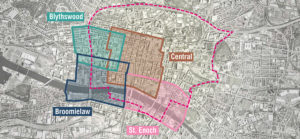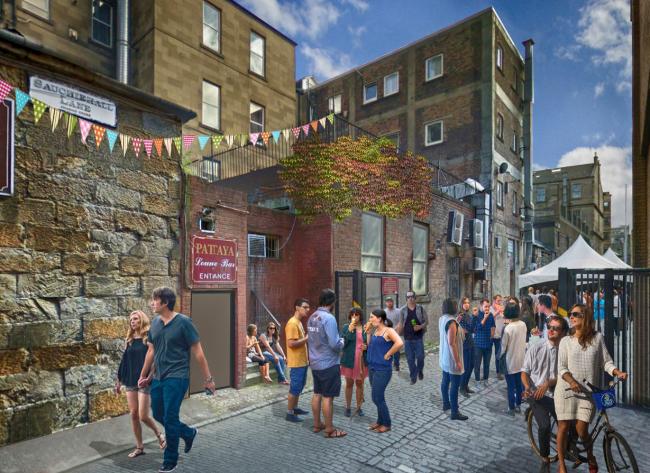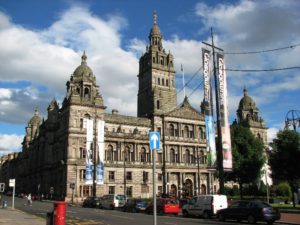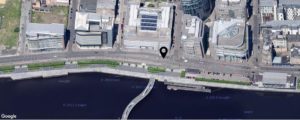Glasgow, Scotland needs to be remodelled. On this, almost everyone from the public through to urban designers agrees. The city needs to be more walkable, greener, more liveable, more attractive to tourists. It needs to fill up its vacant spaces and empty wastelands.
Glasgow needs to populate its city centre with a more diverse demographic, and create a truly 24-hour life city. It needs to make the River Clyde and its quays the kind of centre point, the public heart, that rivers provide in so many other European cities. Abandoned lanes need to be turned into thriving hubs for restaurants, bars, artists and entrepreneurs.
Susan Aitken, a local politician, wants to see the city become the next Barcelona, Berlin, or Copenhagen. Some big changes are already being planned through the Glasgow City Centre Districts Regeneration Framework.
Currently leading this vision are Winy Maas, architect and co-founder at the innovative Rotterdam-based MVRDV studio, and Graham Ross of Austin Smith Lord, Glasgow-based architects. They speak of a Glasgow in which a “great linear park” might run along the Clyde, in which wasteland and vacant spaces are put to use, in which there are markets, street food festivals, buzzing city lanes.
But, they point out, this is not just their vision. Key to creating it are the people of Glasgow. This is, and has been, about consulting Glaswegians for big ideas, in a collective brainstorming and engagement process. Ross says: “The key thing has been engaging with Glaswegians, the local communities – and the passion that Glaswegians have and that gallusness and creativity, is something we’re really trying, through the process, to be faithful to. We want to come up with a distinctively Glaswegian response to the issues.”
In Glasgow just a year ago, there were around 1,900 long-term empty properties. Since then the Glasgow Shared Services Empty Homes Project has already helped bring 200 of them back into use. It’s aiming to bring between 25% to 30% them back into use over a five-year period.
Adam Lang, Head of Communications and Policy at Shelter Scotland, a partner in the project, says: “Bringing long-term empty properties back into use is part of the answer to our housing crisis. The approach that is being taken in Glasgow recognises that empty homes are not just contributing to the housing shortage but cause significant problems for communities as well.”
Today Councillor Frank McAveety, Glasgow City Council’s Leader, launched the next stage of the city’s ten year regeneration strategy alongside MVRDV co-founder Winy Maas and Austin-Smith:Lord partner Graham Ross.
 On August 29, 2016, the next stage of the Glasgow City Centre Districts Regeneration Framework was launched. It focuses on four of the nine districts within the city centre: Broomielaw, Blythswood, Central and St. Enoch.
On August 29, 2016, the next stage of the Glasgow City Centre Districts Regeneration Framework was launched. It focuses on four of the nine districts within the city centre: Broomielaw, Blythswood, Central and St. Enoch.
MVRDV and Austin-Smith:Lord led the council and stakeholders engagement process in order to deliver the framework as part of a multi-disciplinary team with expertise in: architecture, connectivity, delivery, economics, engineering, finance, landscape, planning, sustainability and urban design. This will be the first time that stakeholders in these districts have had the collective opportunity to get involved and offer their opinions and aspirations for regeneration and physical change.
“It is both an incredible pleasure and a great responsibility to work on the transformation of Glasgow’s heart because it touches people’s lives and the identity of their city. For this reason we collaborate with the Glaswegians on their city.” said Winy Maas, “The project is titled (Y)OUR CITY CENTRE and it is an overall plan made of many elements ranging from larger scale interventions concerning liveability, the infrastructure, the meaning of the river; to the small scale in which bottom-up initiatives, street furniture and the development of small plots is considered. The outcome will be presented to the citizens for an open dialogue about the future of Glasgow.”
The first stage was carried out in 2015 in two other districts of Glasgow. After the public consultation with local stakeholders recommendations for the regeneration of the district included improved access through a cycle and pedestrian bridge as well as a new urban park over the motorway. Other suggestions focussed on improving the quality of life within the city, encouraging better connectivity and harnessing local identity and vibrancy.
Key priorities for the regeneration of the city centre include: improving the urban environment, driven by the creation of avenues which will offer vastly improved accessibility between and throughout the city’s districts; promoting cycling and walking; economic growth; development of vacant sites; and attracting investment.
During recent consultations with Glaswegians, says Graham Ross of Austin Smith Lord, the river front was the number one issue that was raised. “Everyone,” he says, “relays their own anecdote on other cities where the river becomes a natural gathering place rather than a place which divides.”
Among the challenges is making sure that people can get to the water’s edge and along the river, since the city is designed for traffic and cars rather than walking. The current strategy will aim to create “a city which is highly walkable” and in which “people are enabled to get right from the city centre down to the water’s edge in a far more intuitive, more pleasant and safer environment.” Once they get there, Ross says “there may be bars, restaurants, trim trails and activities on both banks”.
One of the ideas being floated is of a “great, linear park” along the Clyde, stretching from Glasgow Green to the Riverside Museum and then up the Kelvin to Kelvingrove Park.
Image credit: MVRDV.



